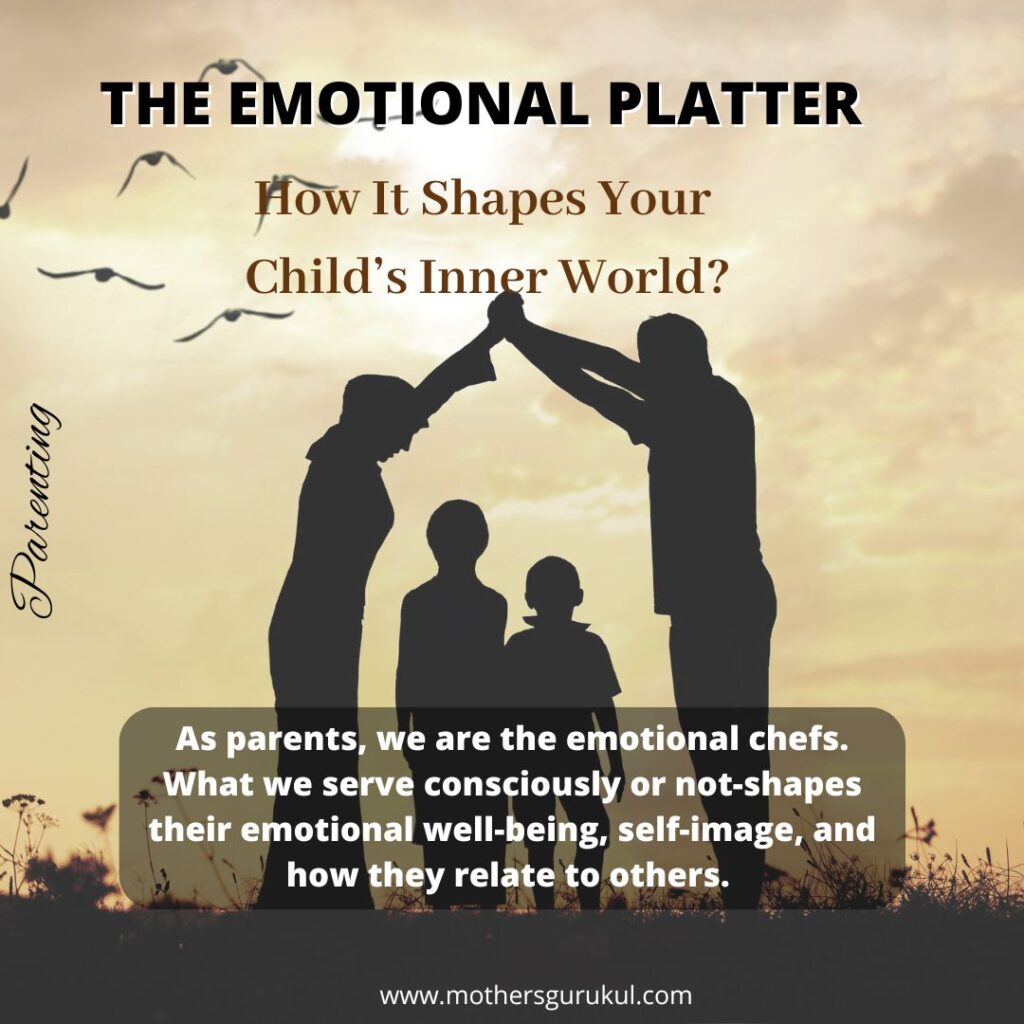We are all familiar with the concept of a balanced meal—making sure our kids get enough greens, proteins, and nutrients for healthy physical growth. But have you ever thought about the emotional platter we serve them every day?
Just like we prepare nutritious meals for our children, we also serve them a daily emotional platter -through words, reactions, tone, and presence.

Recently I shared a video on my Instagram page about our emotional platter. I got multiple queries about it. As a parent & kids life coach, I see parent’s emotional platter quite often. I explain them the importance of maintaining a balance approach in their style. I encourage them to set boundaries with compassion and love.
Parenting can get stressful on several occasions. Sometimes, our kids provoke us through their words or actions. We feel helpless and sad at the same time. It is hard to point out who is escalating the situation. I know it’s confusing. And that’s why, it becomes even more important to take care of our emotional platter and be mindful about what are we serving our children.
View this post on Instagram
What Is an Emotional Platter?
Just like a food platter contains a mix of items that nourish the body, an emotional platter consists of the experiences, responses, and feelings we offer our children. These could include:
- Love and affection
- Patience and understanding
- Guidance and structure
- Trust and encouragement
- Boundaries and discipline
But it can also (unintentionally) include:
- Stress and frustration
- Neglect or distraction
- Overreaction or inconsistency
- Pressure and comparison
- More correction and less connection
The emotions we frequently display become part of our child’s emotional diet. As parents, we are the emotional chefs. What we serve consciously or not-shapes their emotional well-being, self-image, and how they relate to others.
Why It Matters?
Children absorb more from what they experience than what they are told. If we consistently serve chaos, criticism, or coldness, they may internalize those messages and carry them into adulthood.
But when we offer a stable emotional platter—rich in love, empathy, and consistent boundaries—we equip them to build emotional intelligence, self-confidence, and healthy relationships.
How to Create a Healthy Emotional Platter?
Here are some ideas to reflect on and implement:
1. Start With Self-Awareness
Your emotional state directly influences your child. Pause and ask:
- What am I feeling right now?
- Am I reacting or responding?
- What emotion am I unintentionally passing on? This is teaching that everyone has emotions and managing them is a part of life.
If you are stressed or overwhelmed, say I am feeling overwhelmed, so I am going to sit quietly for a few minutes to reset.
2. Serve Presence Over Perfection
You don’t have to be a perfect parent. Being present, listening without rushing to fix, and acknowledging your child’s feelings is more powerful than always having the “right” answer. Sometimes our kids do not need our wisdom. They want us to just listen them.
3. Balance Warmth With Boundaries
Being emotionally available doesn’t mean saying yes to everything. Boundaries served with warmth help children feel secure and respected. A parent can be emotionally warm and still hold firm to values, expectations, and limits. A calm voice paired with consistent boundaries often has a deeper and long-lasting impact.
4. Offer a Safe Space for All Emotions
Make your home a space where it’s okay to feel—whether that’s joy, sadness, frustration, or fear. Emotions aren’t problems to solve, they’re messages to understand. When we dismiss their emotions (stop crying, there is nothing to be scared of), kids learn to suppress instead if express. When emotions are welcomed with empathy, kids learn to understand, manage, and communicate.
5. Model Emotional Regulation
Your child is watching how you handle your anger, sadness, or overwhelm. Name your feelings out loud. Show them how to take a break, breathe, or reset when emotions run high.
For example, when your child talks back o breaks a rule, take a deep breath, count to 5 and speak slower than usual. And say, I am upset right now, so I am going to take a minute before I respond. It is teaching your child that it is okay to step away and calm down before solving a problem. And emotional regulation is a skill, not automatic.
We cannot control every emotion that comes up in parenting—there will be messes, meltdowns, and moments of regret. But we can become more mindful of the emotional platter we offer each day. And when we serve it with love, even the hard moments become part of our children’s emotional growth.
I am leaving you with a reflective prompt:
